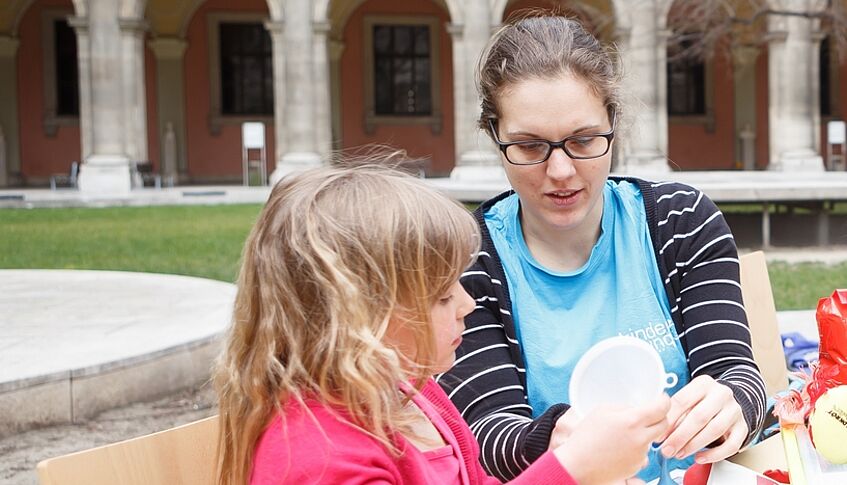Key areas of research

How do children learn in social interactions?

When people communicate, they unconsciously synchronize their behavior, expressions and gestures and – as recent research shows – their rhythmic brain activities. Being "in sync" with each other seems to be essential for effective communication. It is less clear whether this is also the case in early development. Is there mutual alignment on the neural, physiological, and behavioral level between children and adults and does this predict whether the child is able to learn something in the interaction? We investigate social learning in dynamic live interactions between children and adults. We seek to better understand the mechanisms underlying social learning in early childhood in order to find ways to support children in their cognitive and social development.
Publications
- Nguyen, T., Abney, D. H., Salamander, D., Bertenthal, B. I., & Hoehl, S. (2021). Proximity and touch are associated with neural but not physiological synchrony in naturalistic mother-infant interactions. NeuroImage, 244, 118599. [DOI]
- Hoehl, S., Fairhurst, M., & Schirmer, A. (2020). Interactional Synchrony: Signals, Mechanisms, and Benefits. Social Cognitive and Affective Neuroscience, 16(1-2), 5-18. [DOI]
- Nguyen, T., Schleihauf, H., Kayhan, E., Matthes, D., Vrtička, P., & Hoehl, S. (2020). The effects of interaction quality on neural synchrony during mother-child problem solving Cortex, 124, 235-249.[DOI]
- Markova, G., Nguyen, T., & Hoehl, S. (2019). Neurobehavioral interpersonal synchrony in early development: The role of interactional rhythms. Frontiers in Psychology, 10:2078.[DOI]
How do babies direct their attention?

Shortly after birth babies orient their attention towards other people. This is crucial for building first relationships. It may also help infants to structure the immense amount of new sensory inputs they encounter and to direct their limited attentional resources towards important things in the environment. Using eye tracking we investigate which stimuli direct infants' attention effectively toward events and objects in the environment. We are especially interested in the mechanisms and developmental processes underlying infants' remarkable susceptibility for social cues such as the eyes. Additionally, we apply a novel method named visual entrainment, when we show babies fast, periodic visual stimuli in the form of flickering pictures or videos. Brain oscillations can tune into the frequencies of such visual flickering and this can be measured by electroencephalography. Thus this method can help us to detect where babies direct their attention on the neural level and how their visual attention is influenced by social interactions.
Publications
- Michel, C., Pauen, S., & Hoehl, S. (2022). When it pays off to take a look: Infants learn to follow an object’s motion with their gaze – especially if it features eyes. Infancy, 00, 1– 0. [DOI]
- Köster, M., Langeloh, M., & Hoehl, S. (2019). Visually entrained theta oscillations increase for unexpected events in the infant brain. Psychological Science, 30(11) 1656–1663.[DOI]
- Michel, C., Wronski, C., Pauen, S., Daum, M., & Hoehl, S. (2017). Infants' object processing is guided specifically by social cues. Neuropsychologia, 126, 54-61.[DOI]
- Michel, C., Stets, M., Parise, E., Reid, V. M., Striano, T., Hoehl, S. (2015). Theta- and alpha-band EEG activity in response to eye gaze cues in early infancy. NeuroImage 118, 576 - 583.
How do emerging adults experience the transition into adulthood?

- To what extent do emerging adults feel themselves adult?
- How do emerging adults experience the transition from adolescence to adulthood?
- What criteria do emerging adults perceive necessary to be considered adult?
- How do emerging adults experience their relationship to parents in the transition to adulthood?
- What is the role of parents in their emerging adults’ perceived competence regarding financial matters?
Answers to these questions regarding coping with transitions - especially the transition from adolescence to adulthood - are part of my research interest. In this context it is also important for me taking into account context and personality variables.
Publications
- Sirsch U., Dreher E., Mayr E., Willinger U. (2009). What does it take to be an adult in Austria? Views of adulthood in Austrian adolescents, emerging adults, and adults. Journal of Adolescent Research, 24, 275-292. [DOI]
- Zupančič, M., Friedlmeier, W., Puklek Levpušček, M., Sirsch, U., Bruckner-Feld, J., & Horvat, M. (2014). Perceptions of achieved criteria for adulthood among Austrian, Slovene, and U.S. students. Sage Open, 4, 1–12. [DOI]
